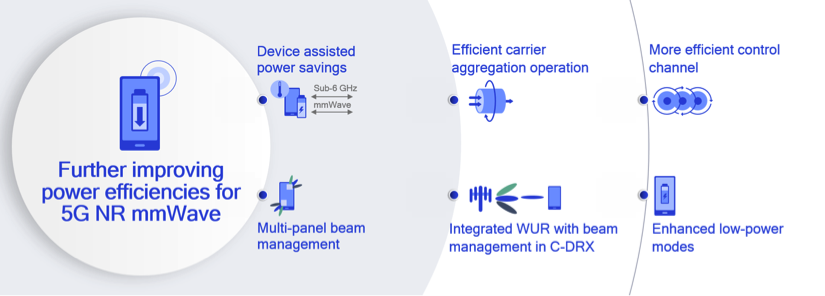Five key 5G NR technologies to enhance millimeter wave (mmWave) system performance and deployment efficiency in 3GPP Release 16 and beyond
Since I wrote about how we solved the impossible challenge of mobilizing mmWave in 2019, the mobile ecosystem has made tremendous progress commercializing 5G mmWave systems. We now have commercial 5G mmWave networks deployed in the U.S. and other regions of the world that support extreme capacity and blazing-fast download speeds, and there is a growing selection of 5G mmWave devices — smartphones, laptops, and more. Momentum behind 5G continues to grow, and I expect to see accelerated 5G network expansion and 5G device proliferation in the months and years to come.
On the research front, we are only at the beginning of our journey when it comes to advancing mmWave technologies. 3GPP Release 16 and beyond are building on the solid 5G NR technology foundation to bring even better mmWave system capability, performance, and efficiency. For the rest of this blog post, I will outline the five key technology areas that my team has been focusing on to propel 5G mmWave to the next level.
Integrated access and backhaul (IAB) for more cost-efficient mmWave deployment
One daunting challenge that mobile operators will face when expanding 5G mmWave network coverage is the cost of deploying additional base stations for mmWave, which usually requires new fiber optics backhaul installations. Release 16-defined IAB allows a base station to not just provide wireless access for its user devices (e.g., smartphones) but also the ability to backhaul wirelessly via neighboring base stations using the same mmWave spectrum. IAB opens the door to more flexible densification strategies, allowing mobile operators to quickly add new base stations to their networks before having to install new fiber to increase backhaul capacity. Release 16 established foundational IAB capabilities, such as dynamic topology adaptation for load balancing and blockage mitigation, and Release 17+ will further enhance IAB by bringing new features like full-duplex operation, topology redundancy, and ML-based network management.
Last year, we virtually showcased our advanced 5G research, and for IAB, we simulated a mmWave network cluster in downtown Frankfurt, Germany. It demonstrated how IAB can significantly improve mmWave coverage and thus enhance user experiences. Scroll down to the bottom of this blog post to watch the full demonstration video, or you can go directly to the video here.

Enhanced beam management for better mmWave performance and robustness
5G mmWave beam management is an area of research that will continue to take place for the foreseeable future. Release 16+ beam management will bring enhanced reliability and performance, especially for mobility use cases. For instance, Release 16 added support for multiple antenna panels (i.e., multiple transmission and reception points — multi-TRP) that improves throughput and diversity. More flexible beam selection (e.g., decoupling of uplink and downlink) can also optimize performance in both directions. In addition, multi-beam repetitions and enhanced beam failure recovery procedures further improve mmWave system robustness. Release 17, which is currently in progress, will further reduce beam management signaling overhead and support expanded beam selection to bring improved intra- and inter-cell mobility.
New power saving techniques for longer battery life
While 5G mmWave unlocks the ultra-wide bandwidth opportunity (i.e., delivering multi-Gbps at much lower cost-per-bit), mmWave-enabled devices face additional power and thermal performance challenges as they operate at much wider bandwidths (e.g., 400/800 MHz) than traditional cellular systems. Release 16 and 17 introduce a broad range of power saving features that can further improve device power efficiency, such as reduced signaling overhead, faster link feedback, and maximized device sleep duration. See below figure for more detail and check out our power-saving system simulations.

Unlicensed and higher mmWave spectrum for more bandwidths
5G NR in unlicensed spectrum (NR-U) was standardized in Release 16 and it is a key enabler for the 5G expansion to new use cases and verticals, providing expanded spectrum access to mobile operators, service providers, and industry players. At the same time, we are starting to push the mmWave boundary to even higher bands toward the sub-Terahertz (i.e., >100 GHz) range. Expected in Release 17, 5G NR will support spectrum bands up to 71 GHz, leveraging the 5G NR Release 15 scalable numerology and flexible framework. This opens up 5G to operate in the globally unlicensed 60 GHz band, which can fuel a broad range of new applications and deployments.

New use cases for expanding beyond enhanced mobile broadband (eMBB)
Continued technology evolution is rapidly expanding 5G’s reach, and mmWave brings important benefits to a wide range of new use case opportunities. For instance, Release 16 delivers enhanced capabilities in mmWave and sub-7 GHz to meet more stringent latency and reliability requirements (i.e., up to 99.9999%), allowing 5G to address high-performance industrial IoT use cases such as factory automation. In addition, mmWave’s ultra-wide bandwidth can enable high-precision positioning, which is beneficial for industrial and broader vertical use cases. For the lower complexity IoT, 5G NR-Light (aka Reduced Capability), defined in Release 17, will expand the reach of mmWave to lower-tier devices (e.g., wearables and industrial sensors) using narrower bandwidth operations (e.g., 50/100 MHz). Also in Release 17 is a Study Item on extended reality (XR), including virtual reality and augmented reality, that will further optimize 5G networks for XR experiences. To learn more on this, watch our demonstration video of our OTA test network in San Diego.

Learn more
There is a great deal of on-going mmWave R&D at Qualcomm Technologies and the wireless industry, and I am very excited and encouraged by the progress we have made so far. I look forward to the continued evolution of 5G in the decade to come and I encourage you to stay tuned for future updates on our progress!
To hear more about 5G mmWave, watch our RCR Wireless webinar and download this presentation. Also, you should read this blog post to understand the economics of deploying 5G mmWave and find out how mmWave networks perform.
Sign up for our wireless technologies newsletter to stay up to date as we move the forward with tomorrow’s technology innovations.
Watch 5G Mobile mmWave Technology Evolution video here.

